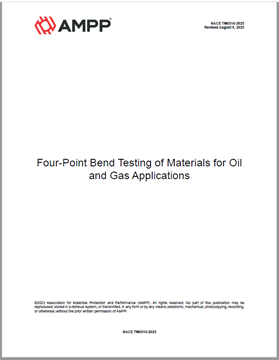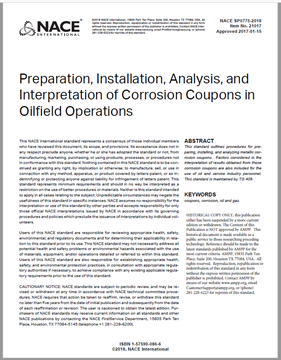Search
Oil and Gas Exploration
View as
Sort by
Display
per page
NACE SP0291-2023, Care, Handling, and Installation of Internally Plastic-Coated Oilfield Tubular Goods and Accessories
Product Number:
NACE SP0291-2023
Publication Date:
2023
$109.00
This standard practice covers the care, handling, transportation, and installation of internally plastic-coated (IPC) oilfield tubular goods and accessories (IPC material). Some internal plastic coatings are inherently brittle or may be incom- patible with various chemicals used in oil and gas production operations and therefore are susceptible to damage from poor handling procedures, well operations, and chemical attack. Coating damage (e.g., cracks, chips, and disbond- ment) reduces coating effectiveness and results in premature coating failure.
NACE SP0499-2012 "Corrosion Control and Monitoring in Seawater Injection Systems"
Product Number:
21237-SG
Publication Date:
2012
$179.00
NACE TM0316-2023, Four-Point Bend Testing of Materials for Oil and Gas Applications
Product Number:
NACE TM0316-2023
Publication Date:
2023
$109.00
Remediation of Microbially Contaminated Horizontal Wells with Acrolein
Product Number:
51320-14992-SG
Publication Date:
2020
$20.00
SP0775-2012-SG (Spanish), “Preparación, Instalación, Análisis, e Interpretación de Cupones de Corrosión en operaciones Petrolíferas”
Product Number:
21185-SG
ISBN:
1-57590-086-6
Publication Date:
2012
$179.00
SP0775-2013-HD2013-SG "Preparation, Installation, Analysis, and Interpretation of Corrosion Coupons in Oilfield Operations"
Product Number:
21017-HD2013
ISBN:
1-57590-086-6
Publication Date:
2013
$179.00
SP0775-2018 "Preparation, Installation, Analysis, and Interpretation of Corrosion Coupons in Oilfield Operations"
Product Number:
21017-SG
Publication Date:
2018
$179.00
TM0194-2014-SG (Spanish), “Monitoreo en Campo del Crecimiento Bacteriano en los Sistemas de Gas y Petróleo”
Product Number:
21266-SG
ISBN:
1-57590-192-7
Publication Date:
2014
$179.00
TM0194-2014-SG, Field Monitoring of Bacterial Growth in Oil and Gas Systems
Product Number:
21224-SG
ISBN:
1-57590-192-7
Publication Date:
2014
$109.00
TM0198-2020, “Slow Strain Rate Test Method for Screening Corrosion-Resistant Alloys for Stress Corrosion Cracking in Sour Oilfield Service”
Product Number:
TM0198-2020
ISBN:
1-57590-051-3
Publication Date:
2020
$109.00
TM0399-2018, Determination of Phosphonate Concentration in Water
Product Number:
21238-SG
ISBN:
1-57590-084-X
Publication Date:
2018
$109.00
TM0399-HD2005-SG Standard Test Method for Phosphonate in Brine
Product Number:
21238-HD2005
ISBN:
1-57590-084-X
Publication Date:
2005
$179.00












